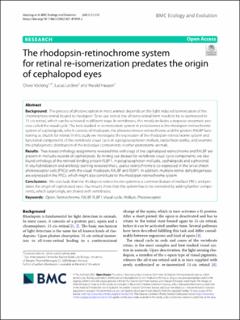| dc.description.abstract | Background: The process of photoreception in most animals depends on the light induced isomerization of the chromophore retinal, bound to rhodopsin. To re-use retinal, the all-trans-retinal form needs to be re-isomerized to 11-cis-retinal, which can be achieved in different ways. In vertebrates, this mostly includes a stepwise enzymatic process called the visual cycle. The best studied re-isomerization system in protostomes is the rhodopsin-retinochrome system of cephalopods, which consists of rhodopsin, the photoisomerase retinochrome and the protein RALBP functioning as shuttle for retinal. In this study we investigate the expression of the rhodopsin-retinochrome system and functional components of the vertebrate visual cycle in a polyplacophoran mollusk, Leptochiton asellus, and examine the phylogenetic distribution of the individual components in other protostome animals.
Results: Tree-based orthology assignments revealed that orthologs of the cephalopod retinochrome and RALBP are present in mollusks outside of cephalopods. By mining our dataset for vertebrate visual cycle components, we also found orthologs of the retinoid binding protein RLBP1, in polyplacophoran mollusks, cephalopods and a phoronid. In situ hybridization and antibody staining revealed that L. asellus retinochrome is co-expressed in the larval chiton photoreceptor cells (PRCs) with the visual rhodopsin, RALBP and RLBP1. In addition, multiple retinal dehydrogenases are expressed in the PRCs, which might also contribute to the rhodopsin-retinochrome system.
Conclusions: We conclude that the rhodopsin-retinochrome system is a common feature of mollusk PRCs and predates the origin of cephalopod eyes. Our results show that this system has to be extended by adding further components, which surprisingly, are shared with vertebrates. | en_US |

